Explore Our Evolution through the Decades
The Beginning
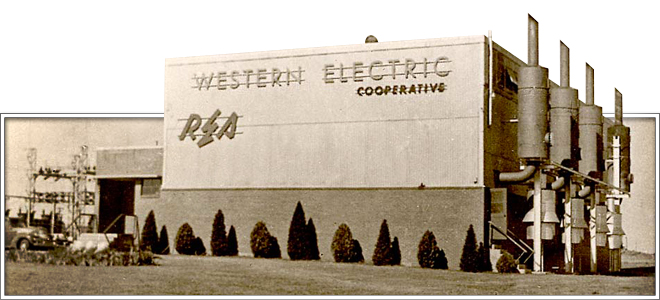 Western Farmers Electric Cooperative (WFEC) is a generation and transmission cooperative that provides essential electric service to 21 member cooperatives, Altus Air Force Base, and other power users. WFEC has been in existence for 80 years, and has grown into Oklahoma’s largest locally owned power supply system. WFEC was organized in 1941 when western Oklahoma rural electric distribution cooperatives found it necessary to secure an adequate power supply at rates farmers and rural industrial developers could afford.
Western Farmers Electric Cooperative (WFEC) is a generation and transmission cooperative that provides essential electric service to 21 member cooperatives, Altus Air Force Base, and other power users. WFEC has been in existence for 80 years, and has grown into Oklahoma’s largest locally owned power supply system. WFEC was organized in 1941 when western Oklahoma rural electric distribution cooperatives found it necessary to secure an adequate power supply at rates farmers and rural industrial developers could afford.
On February 21, 1941, representatives of nine rural electric distribution cooperatives met in Oklahoma City to form a generation and transmission cooperative to be owned by the cooperatives it served. The incorporators provided for individual rural electric cooperatives to petition for membership. On April 25, 1941, the cooperative approved the membership of six cooperatives. These six members were joined by four other cooperatives later that year.
In April 1942, Anadarko was chosen as the location for WFEC’s headquarters. Thirty acres of land was purchased just outside the northeastern city limits. In cooperation with the government, the Board of Trustees shut down construction at the start of World War II, and released the newly acquired generators to be used in the war effort “to aid in the defense of our country.” When the war ended, WFEC added an eleventh member, and after construction was complete, WFEC started producing power in 1950.
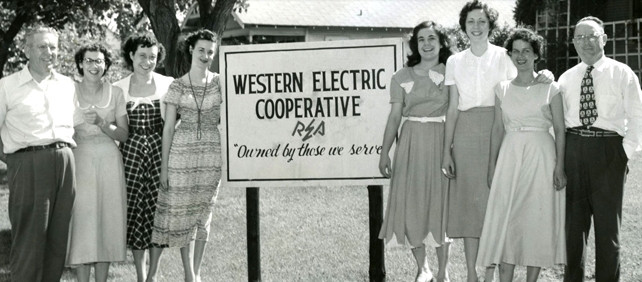
During the 60s
Eight eastern Oklahoma rural electric distribution cooperatives joined WFEC in 1968, bringing the total number of member-owners to 19.
Also in 1968, another 125,000 kilowatt (kW) addition was completed at Mooreland. Sales and income continued to increase and rates remained stable. Power plants at Anadarko and Mooreland received high marks in the early 1970s, based on operating efficiency.
Highlights from the 70s
 As gas contracts expired, WFEC faced prices that were much higher than the original deals. A fuels division was created in 1974, and for the first time WFEC became involved in the production of natural gas. In 1975, Mooreland’s capacity was again boosted by 135,000 kW.
As gas contracts expired, WFEC faced prices that were much higher than the original deals. A fuels division was created in 1974, and for the first time WFEC became involved in the production of natural gas. In 1975, Mooreland’s capacity was again boosted by 135,000 kW.
Due to inflation factors, the cost of generation in the mid-1970s jumped from 8.66 mills per kilowatt-hour (kWh) to 13. For the first time, WFEC leaders began to explore coal and nuclear generation as alternatives. One bright spot during the turbulent 1970s was the completion of the 300,000 kW combined cycle unit at Anadarko, which was 10 times the size of the original system. It was praised then as the most thermal efficient concept in the world.
By 1976, engineering studies began for a 400,000 kW coal-fired generating plant in eastern Oklahoma. At a news conference in October 1977, after considering 51 possible sites, it was announced that the coal plant would be built near Fort Towson, east of Hugo.
Also in 1976, WFEC entered into agreements with Public Service Company of Oklahoma and Associated Electric Cooperative of Springfield, Missouri to be part owner of the giant Black Fox nuclear facility to be built in northeast Oklahoma. Groundbreaking at the Black Fox location was hosted in August 1978. Site preparation work had been given the go-ahead and numerous permits had been received.
To control peak demands, a load management program was considered, following a survey in which members indicated that they were already practicing energy conservation.
Into the 80s
As the time approached for the Hugo Power Plant to come online in the early 1980s, six miles of railroad was built into the coal yard, along with 330 rail cars being purchased. The Hugo Plant went commercial on April 1, 1982. While construction at Hugo moved ahead steadily, the Black Fox project was at a standstill, due to nationwide opposition to nuclear generation following the Three Mile Island accident. In February 1982, the three utility owners agreed to terminate Black Fox and withdrew licensing application, which had been pending since 1975.
In Anadarko, a four-story addition was added to the office facilities, with completion in 1980.
In the late 1980s, a push began to sell surplus power. Cities, including Anadarko, Cordell, Ft. Supply, Lindsay, Mooreland and Anthony, Kan., Electra, Texas and Clarksville, Ark. began looking to WFEC for direct service.
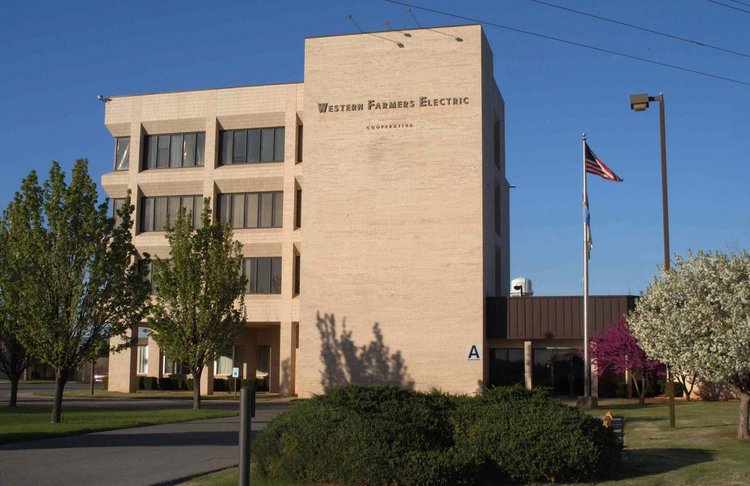
On to the 90's
As WFEC approached the 1990s, assets were in excess of $650 million, with a total generating capacity of 1,338 megawatts. Power was sent along some 3,200 miles of line to more than 220 substations. Employees totaled around 418.
New Century
2001-2003
In 2001, the planning phase for capacity studies was completed, with WFEC’s growth rate averaging in excess of 3 percent, calculating to approximately 35 megawatts (MW) a year.
GenCo Units 1 and 2 became operational in May 2001. The new 90 MW power plant is owned by WFEC EnergyCo, LLC.
A suite of Energy Management Services were added through the Marketing department to help in attracting new key account customers for member cooperatives. A push to increase energy efficiency was also promoted, with more than 76,000 compact fluorescent light (CFL) bulbs being given to all WFEC cooperatives for distribution to their own members.
In January 2003, WFEC became the first power supplier to sign a purchase power agreement (PPA) with a wind farm developer. This step would be the first of many into the wind farm development arena. The Blue Canyon Wind Farm, near Lawton, began commercial operation in December 2003, with a nameplate capacity of 74.25 megawatts.
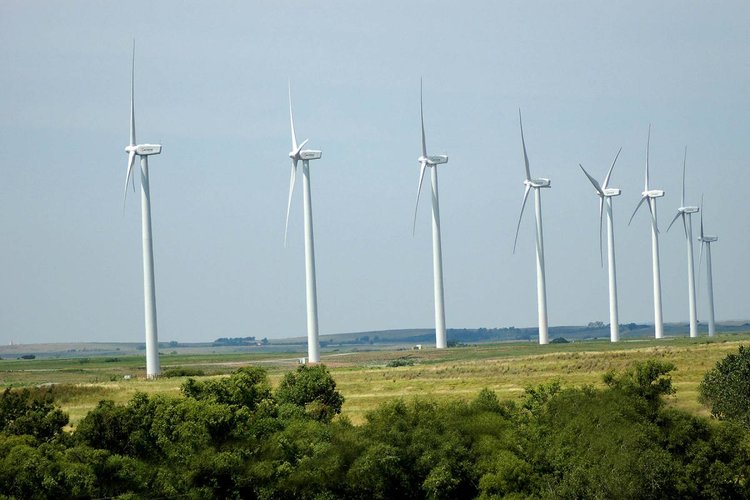
2008
A second PPA was signed in 2008 with Edison Mission Group for the purchase of wind energy from Buffalo Bear Wind Farm, an 18.9 MW facility in Northwest Oklahoma. In keeping up with trends, WFEC signed a third PPA with Acciona Energy for the purchase of wind energy from the Red Hills Wind Farm. This facility, which began commercial operation in June 2009, is located near Elk City, with a nameplate capacity of 123 MW.
Between the three purchases, WFEC had 216 MW of wind energy available, which marked close to 8 percent of WFEC’s fuel blend. However, WFEC currently does not retain or retire all of the environmental attributes from the facilities.
A long-term renewable energy purchase agreement signed in late September 2010 between WFEC and TradeWind Energy will boost WFEC’s wind energy MW total to 366 MW. This wind energy producing facility, a 150 MW site, was completed in June 2012. Named the Rocky Ridge Wind Project, this site is located between Hobart and Cordell, near the community of Rocky.
Currently, some 17 percent of WFEC’s total annual electricity production comes from power purchase agreements with wind farm generators in Oklahoma. However, WFEC currently does not retain or retire all of the environmental attributes from the facilities.
2009
In May 2009, the WFEC headquarters’ site was struck by an EF2 tornado that caused widespread damage to numerous building structures, vehicles, transmission and substation structures, transmission and distribution maintenance buildings and the power plant. No one was injured by the destructive storm, as it hit around 9:30 p.m.
In August 2009, the new Bob Orme Combustion Turbine (CT) Units, located on the east grounds of WFEC’s Anadarko site, were completed. This capacity expansion project, used primarily for peak demand, provided an additional 145 MW of natural gas-fueled electricity generation. The new units are named after longtime WFEC employee Bob Orme, who was serving as the general manager of power production at the time of his death. Significantly, the Bob Orme CT Units represent the first new generation built that is solely owned and operated by WFEC since the Hugo Plant was completed in 1982.
2010
In October 2010, WFEC had the unique opportunity to add four new cooperative members, all headquartered in New Mexico, bringing its total membership to 23. These cooperatives included Central Valley Electric (Artesia); Farmers’ Electric (Clovis); Lea County Electric (Lovington); and Roosevelt County (Portales).
They came to WFEC after learning their PPA agreements would not be extended with their existing power supplier. Together, these four had a total of approximately 400 MW of load. A representative of each cooperative was seated on WFEC’s Board of Trustees.
2011
While much of the national economy continued in recessionary mode in 2011, WFEC member and municipal kWh sales grew some 5.8 percent, despite adverse drought conditions.
2012
As 2012 brought more normalized temperatures, WFEC’s sales growth remained positive in a struggling U.S. economy. Oil and gas development within portions of WFEC’s service footprint presented members with unprecedented growth opportunities, spurring planning, construction and financing of additional infrastructure to meet these rural needs.
2013
WFEC also experienced an optimistic year in 2013, with goals of keeping wholesale rates as low as possible; increasing equity; maintaining positive margins from electric operations; and meeting member load growth needs. WFEC budgeted over $90 million in capital projects, with the majority in the Transmission and Distribution area.
Also during 2013, WFEC spent considerable time working with the Southwest Power Pool (SPP), ACES, and its members in preparation for SPP’s Integrated Marketplace (IM) opening during the first quarter of 2014. Fuel delivery, contract issues in New Mexico, transmission rights, bid strategies, coordination with counter-parties and dozens of other issues were put in place in preparation for the market’s opening on March 1, 2014.
Generation resources remained adequate with a new 100 MW wind contract completed, along with a PPA for natural gas combined cycle generation, scheduled to begin delivery during 2014. Both the wind and power purchase contract positioned WFEC well for continued member growth for the near term.
2014
WFEC’s top billing headlines for 2014 included the impacts of the eventful opening of SPP’s IM. New components of the IM included a day-ahead market, operating reserve markets, reliability unit commitments, transmission congestion rights and other key features. The new market consolidated the 16 different Balancing Authorities (BA) responsible for balancing load and resources into one SPP BA.
So, on March 1, 2014, one of the largest changes in the history of WFEC occurred as WFEC offered to sell all available resources into the SPP IM, as well as purchase all energy required for load commitments.
The first few months of the IM were challenging as all participants, including WFEC, worked to smooth out numerous speed bumps. The market opened during a significant cold spell and high natural gas prices. The initial sharp learning curve trended downward during the last few months of 2014 as the IM began to mature and stabilize.
The availability of gas and gas transportation were just a few of the dozens of issues identified and addressed with the new IM. With the change in BA responsibilities, the sale of certain gas pipeline assets to a third party was authorized in order to gain greater operational flexibility.
In 2014, total energy sales increased a significant 26 percent over 2013, comparing sales of 8.8 million MWh in 2013 with 11.1 million MWh sales in 2014. Increases in oil and natural gas production and infrastructure growth were among factors contributing to this increase and first sales obligation for New Mexico member cooperatives.
As a result of a much colder winter, along with Oklahoma growth, the coincident peak demand tipped the scale at 1,679 MW, establishing a new all-time peak demand on March 2, 2014. This was also the day after the SPP IM market opened, and did not include the load of New Mexico cooperatives.
On May 1, 2014, a milestone of the Transition Agreement with the New Mexico cooperatives was reached when third-party supplier contracts, cooperative-owned generation assets and a renewable energy purchase agreement (REPA) were assigned to WFEC. This generation asset that was declared commercial in February 2012 is located near Lovington, N.M., and consists of five gas-fired reciprocating engine and generator units. Each of the generators is capable of producing 9.3 MW of electricity, for a total of 46.5 MW. Plus, the REPA added the output from an approximate 24.9 MW nameplate rated Wildcat Wind Farm, near Lovington, N.M., to WFEC’s wind farm portfolio.
With the assumption of these contracts, generation assets and REPA, WFEC added the following to its generation resource and capacity mix: 383.0 MW contract capacity of SPS-Xcel blended assets; a 46.5 MW natural gas plant; and 24.9 MW contract capacity of Wildcat Wind Farm.
The U.S. Environmental Protection Agency (EPA) proposed new rules governing carbon dioxide emissions from existing power plants on June 2, 2014, in its proposed Clean Power Plan that created regulatory uncertainty for power generation.
Hugo Plant staff made significant progress towards compliance with the Mercury Air Toxic Rule (MATS), as the unit was scheduled to be in compliance within the required time frame.
In June 2014, an additional long-term natural gas combined cycle resource was placed in service when WFEC began purchasing 160 MW of capacity and energy through a long-term PPA, negotiated in 2012. The PPA provides escalating MW capacity levels and is available through 2035. This efficient generation resource adds excess capacity to cover projected increases in load and delays future generation requirements until approximately 2022.
WFEC’s portfolio of wind energy continued to expand as a result of energy purchase agreements with some 35 MW of energy contracted with four small wind farms in New Mexico, operational in 2014. These include Brahms BEP Wind I and II, near Grady, N.M. and Anderson Wind Project I and II, near Chaves County, N.M.
2015
The 100 MW Balko Wind Project, near Balko, Okla., began commercial operation in 2015, as well as the 50 MW Grant Wind Project, in Grant County, Okla. in 2016. Once these projects were completed, WFEC’s wind energy PPAs totaled 575 MW, with some 19 to 21 percent of its total annual electricity production coming from wind generators in Oklahoma and New Mexico. WFEC does not retain or retire all of the environmental attributes of the energy generated by these facilities.
Diversity in fuel resources has long been a major goal for WFEC, as it plays a critical role with long-term reliability and cost. WFEC entered into a PPA with a solar power facility in New Mexico in early 2015. This 25 MW project, Caprock Solar, would be located south of Interstate 40, about 10 miles from the eastern New Mexico state line. Commercial operation was to begin by late 2016, with WFEC purchasing all of the output from this facility that should cover almost 200 acres.
Final steps were taken on Aug. 31, 2015 to complete the merger of WFEC GENCO, LLC (GenCo) with and into WFEC. Upon this merger, GenCo was dissolved and WFEC assumed the remaining GenCo rights, duties and obligations.
Also in August 2015, members of Caddo Electric Cooperative, located in Binger, and Kiwash Electric Cooperative, located in Cordell, overwhelmingly voted for the consolidation of their distribution cooperatives during their respective annual meetings. The consolidation between these two WFEC member cooperatives was made official on January 1, 2016 to form CKenergy Electric Cooperative.
In September 2015, WFEC trustees authorized the execution of a contract for multiple utility-scale solar generating projects, totaling 18 MW. With this contract, WFEC was to own, operate and maintain each facility, which would each generate between 3 and 5 MW at five selected sites in Oklahoma. Locations included areas near Cyril, Fort Cobb, Hinton, Marietta and Tuttle.
As another part of WFEC’s solar investment, “community solar” projects were also planned for the service areas of interested cooperatives. By late 2015, some 11 members had requested projects. Each venture will be .15 to .25 MW for a total of approximately 3.55 MW.
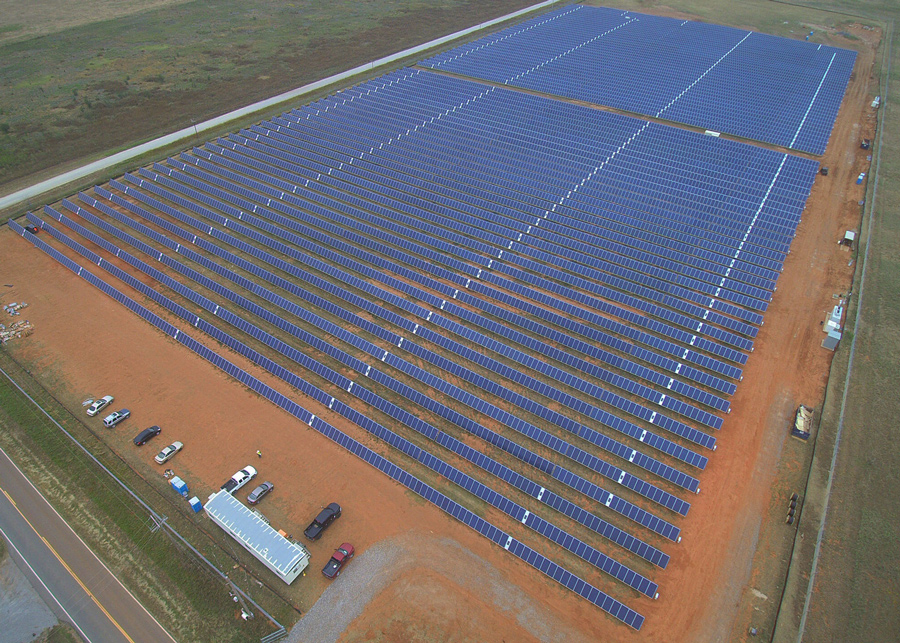
2016
During 2016, WFEC maintained the cooperative’s high credit ratings, margins and ratios during a year of economic slowdown for Oklahoma and New Mexico’s economy. Wholesale power expenses and rates also remained constant, despite the challenges and increasing environmental regulations.
As the Southwest Power Pool (SPP) Integrated Market (IM) continued its evolution, WFEC also saw the market add more transmission line capacity and renewable energy, resulting in a continual reduction to the cost of power provided from the IM. To remain competitive in this market, WFEC staff negotiated new coal supply and rail transportation contracts that added significant optionality in dealing with a carbon constrained future, as well as significant cost reductions.
WFEC worked diligently to remain current with all regulations including the Environmental Protections Agency’s (EPA) Mercury and Air Toxics Standards and Cross State Air Pollution. WFEC also developed plans that will be implemented in 2017 to be compliant with EPA’s Coal Combustion Residuals Rule.
Significant new transmission projects were also placed in service during the year, with WFEC’s 3,700 miles of transmission line remaining reliable and in good condition.
2017
In 2017, WFEC experienced reduced contract sales with several expiring municipal contracts and an accelerated exit schedule of a customer. However, the planned Phase II transfer of load to WFEC from its four New Mexico members occurred as expected on June 1, and would more than offset the loss of load as they continue transitioning from an existing power supplier to full-requirements from WFEC.
A highlight in 2017 was the successful completion of an ongoing effort to extend WFEC member Wholesale Power Contracts from 2050 to 2065, supporting long-term planning and financing of capital investment.
Significant oil and gas development continued in southern New Mexico, and in Oklahoma, Cimarron Electric, Oklahoma Electric and Rural Electric were adding new load from development in the STACK and SCOOP oil plays. The affected areas in Oklahoma required significant investment by WFEC with substations, upgraded lines and new lines.
A new “unbundled” wholesale member rate was approved by the Board of Trustees. This rate reflects separate pricing of major cost components for generation (fixed, variable and fuel costs), transmission and distribution components of providing wholesale electricity, allows more transparency into each component of WFEC’s business costs and allows separate cost recovery.
Multiple utility and community scale solar projects, totaling about 21 megawatts (MW), were placed into commercial service during 2017.
A member education process regarding electric vehicles (EV) was started, with program development around what would possibly be a game changer for the electric utility industry. The latter half of 2017 was spent emphasizing the EV learning curve, which would lead to a coordinated effort to be unveiled in 2018 that would encompass everything from general education and marketing to strategically placed infrastructure development for charging stations.
A groundbreaking ceremony was hosted in December at the site of WFEC’s future 42,000 square foot Moore Office facility at 3000 S. Telephone Road in Moore. Completion was expected in January 2019. The new site was to be located directly south of WFEC’s leased suite of offices at Riverwalk Place (2900 S. Telephone Road). WFEC first expanded its offices to Moore in July 2016, utilizing a suite at Riverwalk Place, with some 26 employees being officed in that location. The initial decision to provide offices in Moore focused on the recruiting and retention possibilities available in a metro location.
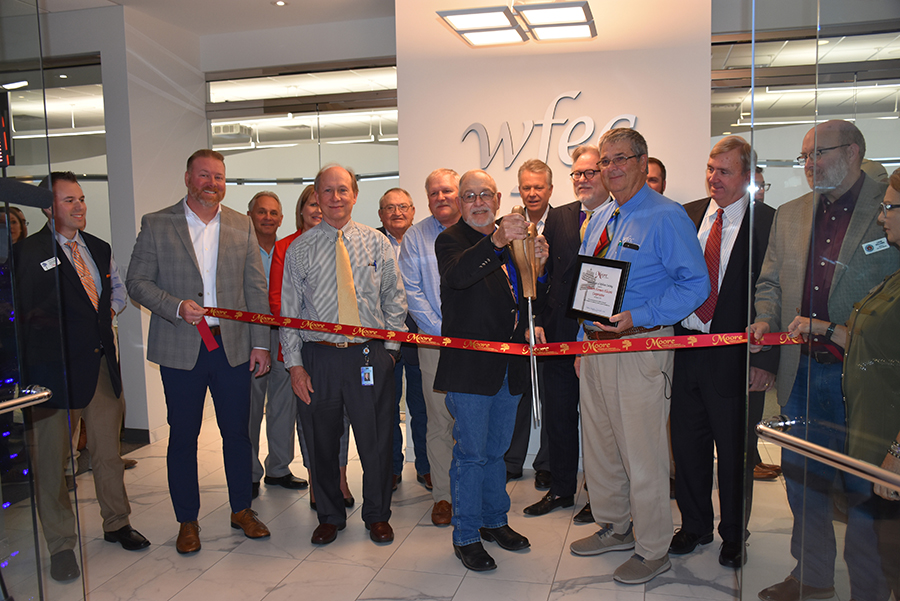
2018
In order to keep wholesale power cost low, WFEC added three new resources, including one wind farm in 2018, an additional wind facility set for 2019, and a solar facility to become operational in 2022. The Minco IV Wind Farm, a 100-megawatt (MW) nameplate facility, was declared commercial in November 2018. This facility near Hinton, Okla., was WFEC’s 12th Renewable Energy Purchase Agreement (REPA) signed with a wind farm developer, which brought WFEC’s wind total to 705 MW by year’s end.
WFEC also negotiated a REPA with NextEra Energy Resources Development, LLC for the purchase of energy produced by Skeleton Creek Wind, LLC. This wind farm was to be located in Alfalfa, Major and Garfield counties of Oklahoma. This facility, with a completion date set for late 2020, would consist of a 250 MW nameplate capacity.
Solar energy was also on track to become a greater portion of WFEC’s overall fuel mix in the next few years. Currently, WFEC owns or contracts almost 51 MW of solar, which includes 18 MW from five utility-scale solar farms in Oklahoma; 30 MW from two utility-scale sites in New Mexico; and almost 3 MW from 13 community solar locations.
WFEC also negotiated a long-term REPA with Invenergy LLC for the purchase of energy, capacity rights and renewable energy attributes from the Tip Top Solar Energy Center to be located in southeast New Mexico. This proposed project is projected to be a 220 MW nameplate capacity site, to be commercially operational by December 2022. These projects, once commercial, would further diversify WFEC’s generation portfolio to consist of 271 MW of solar generation, 955 MW of wind generation and 260 MW of hydroelectric generation.
Effective Dec. 31, 2018, WFEC and three of the four New Mexico member cooperatives, including Farmers’, Lea County and Roosevelt County, mutually agreed to terminate their respective Transition Agreements early. These agreements were signed upon joining WFEC in 2010 and were originally scheduled to terminate in 2026.
Construction continued on a new Moore Office facility throughout 2018. This new construction project began in late 2017, and was nearing completion by year’s end, with occupancy planned for early 2019. The Moore Office was not to replace the headquarters facility in Anadarko, Okla., but rather serve as an alternative office site.
Much of 2018 was also spent emphasizing the electric vehicle (EV) learning curve, as a coordinated effort that continued into 2019, with plans for additional participation from member cooperatives. WFEC began transitioning to a partial fleet of EVs in late 2018, with plans to continue this trend as older vehicles need to be replaced.
2019
In 2019, WFEC continued efforts to strengthen its sound financial structure while maintaining consistent wholesale power rates for members. Long-term, fixed-cost, renewable assets, integrated with traditional fossil fuel assets and maximum Southwest Power Pool Integrated Market (SPP IM) interaction helped maintain stable wholesale power costs.
A highlight in the spring of 2019 was the successful completion of a 44,000 square foot office building, centrally located in Moore, Okla. that had proven to be an attractive recruiting and retention tool. By the end of 2019, this location housed approximately two-thirds of the office and administrative functions of WFEC. While the Transmission and Distribution, Anadarko Power Plant, and System Operations functions will remain at the Anadarko Headquarters, the ability to hire employees from the Oklahoma City metropolitan area contributed to WFEC’s integration of its “next generation” of employees.
An electric vehicle charging infrastructure was developed, through the joint effort of WFEC, along with all member cooperatives, investor-owned utilities, and municipals in rural Oklahoma and New Mexico. This initiative was designed to help develop electric vehicle utilization in both states for the future.
Present Day
WFEC's generating facilities are located at Mooreland, Anadarko and Hugo, Oklahoma and Lovington, New Mexico. WFEC has a total power capacity of more than 2,400 MW when purchased hydropower is included. The G&T owns and maintains more than 3,800 miles of transmission line to more than 330 sub and switch stations. Members consist of 21 distribution cooperatives, located in Oklahoma and New Mexico, with their service territories covering parts of the two states, in addition to portions of Texas and Kansas. WFEC also serves Altus Air Force Base.
WFEC has not only experienced substantial growth opportunities since its 1941 launch, but has also maintained a well-balanced and diversified portfolio of energy resources that includes owned facilities and capacity, in addition to energy provided through power purchase agreements. These resources reflect a mix of technologies and fuel types. The diversity in generation mix helps reduce exposure to changing market conditions, helping to keep rates competitive.
WFEC is well positioned to provide its members’ energy for the long run with adequate generation and transmission assets, sound financials, continued load growth and an excellent group of employees. Throughout this journey, WFEC’s mission to deliver safe, reliable and competitively priced wholesale energy to members remains its primary focus.

